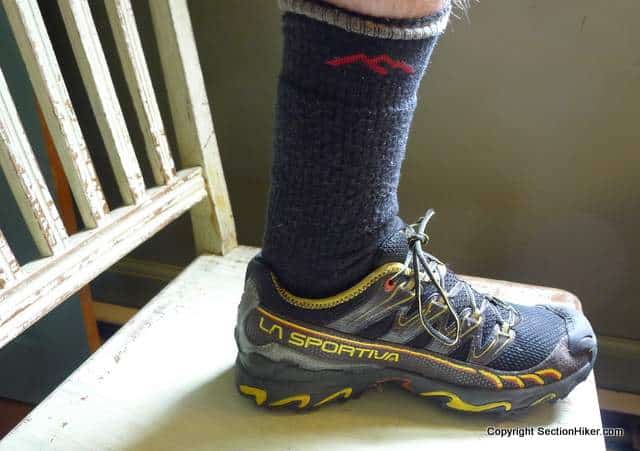
Many people bring too many extra clothes on backpacking trips, including more shirts, pants, pairs of underwear, socks, and even shoes that they don’t need. Extra clothes add a lot of unnecessary weight to a backpack and take up a significant amount of extra volume. So much, that you might end up carrying a larger and heavier backpack than you need.
When it comes to socks, I usually bring two pairs with me on backpacking trips: the pair I’m wearing when I leave the trailhead and a clean pair than I wear at night in my sleeping bag.
When I stop to camp each night, I wash out the pair of socks I’ve been wearing during the day and hang them up to dry. If they’re damp in the morning, I’ll still put them on the next morning, knowing that my body heat will dry them out or that they’re likely to get wet again anyway….stomping through puddles and streams.
Sometimes, socks do wear out if you walk in sandy terrain or gravel accumulates in your shoes, especially if you have to do a lot of stream crossings. In conditions like these, you might want to alternate your socks daily to make them last longer. I wear Darn Tough hiker socks which can take an incredible amount of abuse without wearing out, far more than any other pair of hiking socks, wool or synthetic, that I’ve ever owned. I swear by them. Made out of wool, they’re warm when wet and won’t smell even if you have to wear them for a few days straight. (I take them on business trips for this reason).
Sometimes, the thought of putting a damp pair of socks is too much to bear. I admit it. In which case, I’ll use my clean, dry pair of sleep socks for the day and pin my still damp socks from the previous day to the outside of my backpack with the safety-pin that I keep in my first aid kit. They’re usually dry by suppertime.
What if it’s raining constantly or your second pair of socks won’t dry because the humidity is high?
You can suck it up and hike in wet socks or take a zero and go to town to dry out. Hiking in wet socks is not the end of the world, especially if you wear breathable shoes like mesh trail runners, where your shoes and socks will dry quickly when conditions improve.
The “two pairs of socks system” I describe here is easy to use as long as you remember to wash out the pair of socks you used during the day when you set up camp. Skills and good hygiene habits like washing out your socks each day take a little practice to develop, but they can end up saving you a lot of extra gear weight if you’re diligent about it.
More Footwear Frequently Asked Questions
- When are Hiking Boots Better than Trail Runners?
- Do Sock Liners Prevent Blisters?
- How Many Pairs of Socks Should You Bring on a Backpacking Trip?
- Trail Runners or Hiking Boots for Autumn Weather: When to Switch?
 SectionHiker.com Backpacking Gear Reviews and FAQs
SectionHiker.com Backpacking Gear Reviews and FAQs
Somehow I’m only seeing this post now. A word of caveat: my feet do not heat up well enough to dry out my hiking socks so if I put on a pair of wet socks, unless it’s very very warm out and I don’t step in any other puddles throughout the day, my socks stay wet. So I do bring at least three socks on backpacking trips because otherwise I get trenchfoot. YMMV, but if you have cold feet like I do, be aware that you also may have wet feet all day long.
My WFA (wilderness first aid) trainer said that she learned that it doesn’t matter how wet your feet get throughout the day, as long as you sleep with dry feet you will be much more likely to avoid blisters or trenchfoot. So I also keep a pair of socks buried deep in my pack so that I can be sure they are always dry for sleeping.
Like Philip, I also hike in trailrunners. My wimpy feet cannot handle the hard surfaces of hiking boots; I get blisters almost instantaneously.
Two pairs of socks seems to be enough for me on weekends but if I’m out for three weeks (minimum to get the real benefits) I have to take three pairs. I guess I really just rinse my socks in the evening since I prefer not to use detergents out there and it also gives me an extra day to get them dry. Nothing like pulling dry, seemingly clean socks on my poor tired abused feet to start the day.